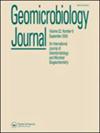九寨沟自然保护区凝灰岩沉积细菌群落特征及原生钙化细菌分离株
IF 2.2
4区 环境科学与生态学
Q3 ENVIRONMENTAL SCIENCES
引用次数: 0
摘要
摘要凝灰岩是岩溶景观中常见的碳酸钙沉积,微生物可能在其形成过程中起重要作用。作为重要的自然资源宝库,九寨沟国家级自然保护区凝灰岩矿床的细菌多样性及其沉积碳酸盐岩的潜力尚不清楚。本研究采用16S rRNA基因测序技术对九寨沟国家级自然保护区珍珠滩细菌群落组成进行了研究。结果表明,主要优势门为变形菌门、蓝藻门、拟杆菌门和放线菌门。随着流量的逐渐增大,细菌群落结构逐渐简化,优势门发生变化。不同样点的群落结构差异显著。此外,采用微生物学方法分离得到17株能沉淀碳酸钙的菌株。两株产钙能力较强的菌株分别为Leucobacter sp. (J1)和Brucella sp. (J2)。两株菌株均能提高环境pH值并产生胞外聚合物(EPS)。然而,白杆菌sp. (J1)形成球形结构的方解石晶体,而布鲁氏菌sp. (J2)形成菱形和一些球形方解石晶体,证明了菌株特有的特征。这是对九寨沟自然保护区凝灰岩沉积物细菌群落多样性和钙化细菌特征的首次研究。关键词:钙化菌株;高通量测序;九寨沟国家级自然保护区;项目资助:九寨沟生态修复专项基金[N51322112022000246]。本文章由计算机程序翻译,如有差异,请以英文原文为准。
Bacterial Communities Associated with Tufa Deposits and Characterization of Indigenous Calcifying Bacterial Isolates from Jiuzhaigou National Nature Reserve, Sichuan, China
AbstractTufa is a common calcium carbonate deposit in karst landscapes and microbes may play an important role in its formation. As an important natural resource treasure trove, the diversity of bacteria from the Jiuzhaigou National Nature Reserve tufa deposits and their potential to deposit carbonates are still unknown. In this study, 16S rRNA gene sequencing technology was used to assess the bacterial community composition of Pearl Shoal in Jiuzhaigou National Nature Reserve. The results showed that the main dominant phyla were Proteobacteria, Cyanobacteria, Bacteroidetes and Actinobacteria. With the gradual increase of flow rate, the bacterial community structure was gradually simplified and the dominant phylum changed. The community structure of different sampling sites was significantly different. Besides, 17 strains capable of precipitating calcium carbonate were isolated using microbiological methods. The two strains with relatively strong calcium-forming properties were identified as Leucobacter sp. (J1) and Brucella sp. (J2), respectively. Both strains were able to elevate the environmental pH and produce extracellular polymeric substance (EPS). However, Leucobacter sp. (J1) formed calcite crystals with spherical structure, whereas Brucella sp. (J2) formed the rhombohedral and some spherical calcite crystals, evidence for strain-specific characteristics. It is the first research to provide information regarding the diversity of bacterial communities associated with tufa deposits and the characterization of calcifying bacteria isolated from Jiuzhaigou National Nature Reserve.Keywords: Calcifying strainshigh-throughput sequencingJiuzhaigou National Nature ReserveTufa Disclosure statementNo potential conflict of interest was reported by the author(s).Additional informationFundingThis work was supported by the Specialized Fund for Ecological Restoration of Jiuzhaigou [N51322112022000246].
求助全文
通过发布文献求助,成功后即可免费获取论文全文。
去求助
来源期刊

Geomicrobiology Journal
环境科学-地球科学综合
CiteScore
4.80
自引率
8.70%
发文量
70
审稿时长
3.3 months
期刊介绍:
Geomicrobiology Journal is a unified vehicle for research and review articles in geomicrobiology and microbial biogeochemistry. One or two special issues devoted to specific geomicrobiological topics are published each year. General articles deal with microbial transformations of geologically important minerals and elements, including those that occur in marine and freshwater environments, soils, mineral deposits and rock formations, and the environmental biogeochemical impact of these transformations. In this context, the functions of Bacteria and Archaea, yeasts, filamentous fungi, micro-algae, protists, and their viruses as geochemical agents are examined.
Articles may stress the nature of specific geologically important microorganisms and their activities, or the environmental and geological consequences of geomicrobiological activity.
The Journal covers an array of topics such as:
microbial weathering;
microbial roles in the formation and degradation of specific minerals;
mineralization of organic matter;
petroleum microbiology;
subsurface microbiology;
biofilm form and function, and other interfacial phenomena of geological importance;
biogeochemical cycling of elements;
isotopic fractionation;
paleomicrobiology.
Applied topics such as bioleaching microbiology, geomicrobiological prospecting, and groundwater pollution microbiology are addressed. New methods and techniques applied in geomicrobiological studies are also considered.
 求助内容:
求助内容: 应助结果提醒方式:
应助结果提醒方式:


